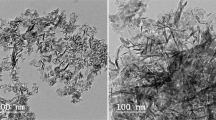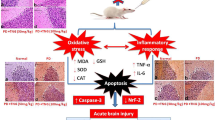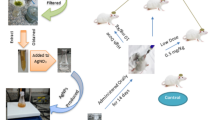Abstract
Objective
The existing work aims to assess the role of hesperidin against silver oxide nanoparticles-induced toxic changes in brain of adult albino rats.
Methods
50 adult male albino rats were divided into four groups: group Ia (−ve control); group Ib (+ve control; saline group); group II (hesperidin (HN); each rat received 50 mg/kg/day orally); group III (AgNPs; each rat received 1 mg/kg/day IP); and group IV (HN and AgNPs in the previous doses) all for 28 days. Then rats were anesthetized and killed, and specimens from the brain were taken for biochemical and histopathological studies.
Results
AgNPs exposure showed significantly increased tissue malondialdehyde (MDA), inducible nitric oxide synthase, caspase 8 and caspase 3 activities with significant depletions of superoxide dismutase activities. This was accompanied with alteration and damage in the histological structure of the brain. These changes were improved in the group receiving HN with AgNPs.
Conclusion
The results of this study showed that hesperidin had protective effects against AgNPs-induced toxicity in rat brain.






Similar content being viewed by others
References
Rosario F, Duarte IF, Pinto RJB, Santos C, Hoet PHM, Oliveira H (2020) Biodistribution and pulmonary metabolic effects of silver nanoparticles in mice following acute intratracheal instillations. Environ Sci Pollut Res 28(2):2301–2314
Chen R, Zhao L, Bai R, Liu Y, Han L, Xu Z et al (2016) Silver nanoparticles induced oxidative and endoplasmic reticulum stresses in mouse tissues: implications for the development of acute toxicity after intravenous administration. Toxicol Res 5(2):602–608. https://doi.org/10.1039/c5tx00464k
Patlolla AK, Hackett D, Tchounwou PB (2015) Silver nanoparticles-induced oxidative stress-dependent toxicity in Sprague-Dawley rats. Mol Cell Biochem 399(1–2):257–268
Lebda M, Sadek KM, Tohamy HG, Abouzed TK, Shukry M, Umerzawa M et al (2018) Potential role of α-lipoic acid and Ginko biloba against silver nanoparticles-induced neuronal apoptosis and blood-brain barrier impairments in rats. Life Sci 212:251–260
Barreca D, Gattuso G, Bellocco E, Calderaro A, Trombetta D, Smeriglio A, Lagana G, Daglia M, Meneghini S, Flavanones NSM (2017) citrus phytochemical with health-promoting properties. BioFactors 43:495–506
Li C, Schluesener H (2017) Health-promoting effects of the citrus flavanone hesperidin. Crit Rev Food Sci Nutr 57(3):613–631. https://doi.org/10.1080/10408398.2014.906382
Manach C, Morand C, Gil-Izquierdo A et al (2003) Bioavailability in humans of the flavanones hesperidin and narirutin after the ingestion of two doses of orange juice. Eur J Clin Nutr 57(2):235–242
Sharma R (2014) Polyphenols in health and disease: practice and mechanisms of benefits. In: Watson RR, Preedy VR, Zibadi S (eds) Polyphenols in human health and disease, Academic Press, Chapter 59, pp 757–778. ISBN 9780123984562. https://doi.org/10.1016/B978-0-12-398456-2.00059-1
Lee K-A, Lee S-H, Lee Y-J, Baeg SM, Shim J-H (2012) Hesperidin induces apoptosis by inhibiting Sp1 and its regulatory protein in MSTO-211H cells. Biomol Ther (Seoul) 20(3):273–279
Parhiz H, Roohbakhsh A, Soltani F, Rezaee R, Iranshahi M (2015) Antioxidant and anti-inflammatory properties of the citrus flavonoid’s hesperidin and hesperidin: an updated review of their molecular mechanisms and experimental models. Phytother Res 29(3):323–333
Docea AO, Calina D, Buga AM, Zlatian O, Paoliello MMB, Mogosanu GD, Streba CT, Popescu EL, Stoica AE, Bîrcă AC, Vasile BȘ, Grumezescu AM, Mogoanta L (2020) The effect of silver nanoparticles on Antioxidant/Pro-Oxidant balance in a murine model. Int J Mol Sci 21(4):1233. https://doi.org/10.3390/ijms21041233. (PMCID: PMC7072874)
Ghosh R, Sarkhel S, Saha K, Parua P, Chatterjee U, Mana K (2021) Synthesis, characterization & evaluation of venom neutralization potential of silver nanoparticles mediated Alstonia scholaris Linn bark extract. Toxicol Rep 8:888–895
Yang X, Liu X, Lu H, Zhang X, Ma L, Gao R et al (2012) Real time investigation of acute toxicity of ZnO nanoparticles on human lung epithelia with hopping probe ion conductance microscopy. Chem Res Toxicol 25(2):297–304
Wang L, Zhang T, Li P, Huang W, Tang J, Wang P et al (2015) Use of synchrotron radiation-analytical techniques to reveal chemical origin of silver-nanoparticle cytotoxicity. ACS Nano 9(6):6532–6547
Park EJ, Bae E, Yi J, Kim Y, Choi K, Lee SH et al (2010) Repeated-dose toxicity and inflammatory responses in mice by oral administration of silver nanoparticles. Environ Toxicol Pharmacol 30:162–168
Adeyemi OS, Faniyan TO (2014) Antioxidant status of rats administered silver nanoparticles orally. J Taibah Univ Med Sci 9(3):182–186. https://doi.org/10.1016/j.jtumed.2014.03.002
Moradi-Sardareh H, Basir HRG, Hassan ZM, Davoudi M, Amidi F, Paknejad M (2018) Toxicity of silver nanoparticles on different tissues of Balb/C mice. Life Sci 211:81–90
Kim SH, Ko JW, Koh SK, Lee IC, Son JM, Moon C et al (2014) Silver nanoparticles induce apoptotic cell death in cultured cerebral cortical neurons. Mol Cell Toxicol 10:173–179. https://doi.org/10.1007/s13273-014-0019-6
Fu PP, Xia Q, Hwang HM, Ray PC, Yu H (2014) Mechanisms of nontoxicity: generation of reactive oxygen species. J Food Drug Anal 22(1):64–75. https://doi.org/10.1016/j.jfda.2014.01.005. (PMCID: PMC9359151)
Skalska J, Dąbrowska-Bouta B, Strużyńska L (2016) Oxidative stress in rat brain but not in liver following oral administration of a low dose of nanoparticulate silver. Food Chem Toxicol 97:307–315
Tiwari R, Singh RD, Khan H, Gangopadhyay S, Mittal S, Singh V et al (2017) Oral subchronic exposure to silver nanoparticles causes renal damage through apoptotic impairment and necrotic cell death. Nanotoxicology 11(5):671–686
Ghaderi S, Tabatabaei SRF, Varzi HN, Rashno M (2015) Induced adverse effects of prenatal exposure to silver nanoparticles on neurobehavioral development of offspring of mice. J Toxicol Sci 40(2):263–275
Al Gurabi MA, Ali D, Alkahtani S, Alarifi S (2015) In vivo DNA damaging and apoptotic potential of silver nanoparticles in Swiss albino mice. Onco Targets Ther 8:295–302. https://doi.org/10.2147/OTT.S77572
Xu L, Shao A, Zhao Y, Wang Z, Zhang C, Sun Y et al (2015) Neurotoxicity of silver nanoparticles in rat brain after intragastric exposure. J Nanosci Nanotechnol 15(6):4215–4223
Trickler WJ, Lantz SM, Murdock RC, Schrand AM, Robinson BL, Newport GD et al (2010) Silver nanoparticle induced blood-brain barrier inflammation and increased permeability in primary rat brain microvessel endothelial cells. Toxicol Sci 118(1):160–170
Garg A, Garg S, Zaneveld L, Singla A (2001) Chemistry and pharmacology of the citrus bioflavonoid hesperidin. Phytother Res 15:655–669
Choi I, Kim S, Jeong H, Park H, Song Y, Lee J, Kang T, Park J, Hwang G, Lee J, Hong S, Kim H, Um J (2007) Hesperidin inhibits expression of hypoxia inducible factor-1 alpha and inflammatory cytokine production from mast cells. Mol Cell Biochem 305(1–2):153–161
Hwang SL, Shih PH, Yen GC (2012) Neuroprotective effects of citrus flavonoids. J Agric Food Chem 60:877–885
Roohbakhsh A, Parhiz H, Soltani F, Rezaee R, Iranshahi M (2014) Neuropharmacological properties and pharmacokinetics of the citrus flavonoids hesperidin and hesperetin: a mini-review. Life Sci 113:1–6
Kumar A, Chaudhary T, Mishra J (2013) Minocycline modulates neuroprotective effect of hesperidin against quinolinic acid induced Huntington’s disease like symptoms in rats: Behavioral, biochemical, cellular and histological evidences. Eur J Pharmacol 720:16–28
Thenmozhi AJ, Raja TRW, Janakiraman U, Manivasagam T (2015) Neuroprotective effect of hesperidin on aluminium chloride induced Alzheimer’s disease in Wistar rats. Neurochem Res 40:767–776. https://doi.org/10.1007/s11064-015-1525-1. (PMID: 25630717)
Lee CJ, Wilson L, Jordan MA, Nguyen V, Tang J, Smiyun G (2010) Hesperidin suppressed proliferations of both Human breast cancer and androgen-dependent prostate cancer cells. Phytother Res. https://doi.org/10.1002/ptr.2856. (PMID: 19548283)
Bartoszewski R, Hering A, Marszałł M, Hajduk JS, Bartoszewska S, Kapoor N, Kochan K, Ochocka R (2014) Mangiferin has an additive effect on the apoptotic properties of hesperidin in Cyclopia sp. tea extracts. PLoS ONE 9:e92128
Maekawa S, Sato K, Fujita K, Daigaku R, Tawarayama H, Murayama N, Moritoh S, Yabana T, Shiga Y, Omodaka K, Maruyama K, Nishiguchi KM, Nakazawa T (2017) The neuroprotective effect of hesperidin in NMDA-induced retinal injury acts by suppressing oxidative stress and excessive calpain activation. Sci Rep 7:6885
Justin-Thenmozhi A, Dhivya Bharathi M, Kiruthika R, Manivasagam T, Borah A, Essa MM (2018) Attenuation of aluminum chloride-induced neuroinflammation and caspase activation through the AKT/GSK-3β pathway by hesperidin in Wistar rats. Neurotox Res 34:463–476
Merzoug S, Toumi M (2017) Effects of hesperidin on formaldehyde-induced toxicity in pregnant rats. EXCLI J 16:400–413
Qin G, Tang S, Li S, Lu H, Wang Y, Zhao P, Li B, Zhang J, Peng L (2017) Toxicological evaluation of silver nanoparticles and silver nitrate in rats following 28 days of repeated oral exposure. Environ Toxicol 32(2):609–618
Ohkawa H, Ohishi N, Yagi K (1979) Assay for lipid peroxides in animal tissues by thiobarbituric acid reaction. Anal Biochem 95(2):351–358. https://doi.org/10.1016/0003-2697(79)90738-3
Montgomery HAC, Dymock JF (1961) The determination of nitrite in water. Analyst 86:414–416
Durak I et al (1999) High-temperature effects on antioxidant systems and toxic product formation in nutritional oils. J Toxicol Environ Health 57:585–589. https://doi.org/10.1080/009841099157520. (PMID: 10515575)
Bancroft JD, Layton C (2013) The Hematoxylin and Eosin. In: Suvarna SK, Layton C, Bancroft JD (Eds) Theory & Practice of Histological Techniques, 7th Edition, Churchill Livingstone of El Sevier, Philadelphia, Ch. 10 and 11, pp 172–214. https://doi.org/10.1016/B978-0-7020-4226-3.00010-X
Goodhew PJ, Humphreys J, Beanland R (2003) Electron microscopey and analysis, 4th edn. Taylor and Francis, London, New York
Acknowledgements
Thanks are due to all the staff work at the animal house of Zagazig Faculty of Medicine and the staff members of the medical histology and cell biology department.
Funding
This study had no special funding from any organization.
Author information
Authors and Affiliations
Contributions
All authors provided a contribution to the conception and design or data analysis in drafting or revising the manuscript.
Corresponding author
Ethics declarations
Conflict of interest
Abeer Ramzy Hussieny Mahmoud and Nashwa Mohamad Mohamad Shalaby declare that we have no conflict of interest.
Ethical approval
The experimental work was done according to the basic instructions advised through the Institutional Research Board for the use and care of experimental animals and approved by The Institutional Animal Care and Use Committee, Zagazig University, with approval code ZU-IACUC/ 3/F/260/2022.
Rights and permissions
Springer Nature or its licensor (e.g. a society or other partner) holds exclusive rights to this article under a publishing agreement with the author(s) or other rightsholder(s); author self-archiving of the accepted manuscript version of this article is solely governed by the terms of such publishing agreement and applicable law.
About this article
Cite this article
Mahmoud, A.R.H., Shalaby, N.M.M. Effectiveness of hesperidin against toxic effect of silver nanoparticles on the brain via apoptotic/antiapoptotic pathway in adult albino rats. Toxicol. Environ. Health Sci. 15, 119–125 (2023). https://doi.org/10.1007/s13530-022-00165-2
Accepted:
Published:
Issue Date:
DOI: https://doi.org/10.1007/s13530-022-00165-2




